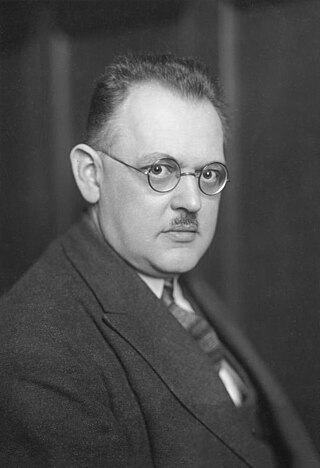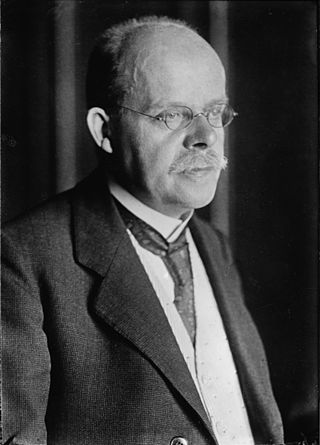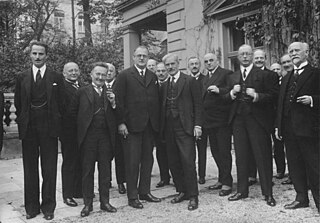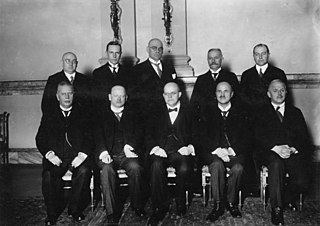
The German People's Party was a conservative-liberal political party during the Weimar Republic that was the successor to the National Liberal Party of the German Empire. Along with the left-liberal German Democratic Party (DDP), it represented political liberalism in Germany between 1918 and 1933.

Hermann Müller was a German Social Democratic politician who served as foreign minister (1919–1920) and was twice chancellor of Germany during the Weimar Republic. In his capacity as foreign minister, he was one of the German signatories of the Treaty of Versailles.

Karl Joseph Wirth was a German politician of the Catholic Centre Party who served for one year and six months as the chancellor of Germany from 1921 to 1922, as the finance minister from 1920 to 1921, as acting foreign minister of Germany from 1921 to 1922 and again in 1922, as the minister for the Occupied Territories from 1929 to 1930 and as the minister of the Interior from 1930 to 1931. During the postwar era, he participated in the Soviet and East German Communist-controlled neutralist Alliance of Germans party from 1952 until his death in 1956.

Wilhelm Marx was a German judge, politician and member of the Catholic Centre Party. During the Weimar Republic he was the chancellor of Germany twice, from 1923–1925 and 1926–1928, and served briefly as the minister president of Prussia in 1925. With a total of 3 years and 73 days, he was the longest-serving chancellor during the Weimar Republic.
Events in the year 1921 in Germany.
Events in the year 1922 in Germany.

The Weimar Coalition is the name given to the centre-leftist coalition of the Social Democratic Party of Germany (SPD), the social liberal German Democratic Party (DDP) and the Christian democratic Centre Party, who together had a large majority of the delegates to the Constituent Assembly that met at Weimar in 1919, and were the principal groups that designed the constitution of Germany's Weimar Republic. These three parties were seen as the most committed to Germany's new democratic system, and together governed Germany until the elections of 1920, when the first elections under the new constitution were held, and both the SPD and especially the DDP lost a considerable share of their votes. Although the Coalition was revived in the ministry of Joseph Wirth from 1921 to 1922, the pro-democratic elements never truly had a majority in the Reichstag from this point on, and the situation gradually grew worse for them with the continued weakening of the DDP. This meant that any pro-republican group that hoped to attain a majority would need to form a "Grand Coalition" with the conservative liberal German People's Party (DVP), which only gradually moved from monarchism to republicanism over the course of the Weimar Republic and was virtually wiped out politically after the death of their most prominent figure, Foreign Minister Gustav Stresemann in 1929.
In the fourteen years the Weimar Republic was in existence, some forty parties were represented in the Reichstag. This fragmentation of political power was in part due to the use of a peculiar proportional representation electoral system that encouraged regional or small special interest parties and in part due to the many challenges facing the nascent German democracy in this period.

The Free State of Prussia was one of the constituent states of Germany from 1918 to 1947. The successor to the Kingdom of Prussia after the defeat of the German Empire in World War I, it continued to be the dominant state in Germany during the Weimar Republic, as it had been during the empire, even though most of Germany's post-war territorial losses in Europe had come from its lands. It was home to the federal capital Berlin and had 62% of Germany's territory and 61% of its population. Prussia changed from the authoritarian state it had been in the past and became a parliamentary democracy under its 1920 constitution. During the Weimar period it was governed almost entirely by pro-democratic parties and proved more politically stable than the Republic itself. With only brief interruptions, the Social Democratic Party (SPD) provided the Minister President. Its Ministers of the Interior, also from the SPD, pushed republican reform of the administration and police, with the result that Prussia was considered a bulwark of democracy within the Weimar Republic.

The first Müller cabinet, headed by Chancellor Hermann Müller of the Social Democratic Party of Germany (SPD), was the third democratically elected government of Germany and the second in office after the Weimar Constitution came into force in August 1919. The cabinet was based on the same three centre-left parties as the preceding Bauer cabinet: the SPD, Centre Party and German Democratic Party (DDP), a grouping known as the Weimar Coalition. It was formed on 27 March 1920 after the government of Gustav Bauer (SPD) resigned as a result of the unsuccessful Kapp Putsch, which it was seen as having handled badly.

The Fehrenbach cabinet, headed by Chancellor Constantin Fehrenbach of the Centre Party, was the fourth democratically elected government of the Weimar Republic. It took office on 25 June 1920 when it replaced the first cabinet of Hermann Müller, which had resigned due to the poor showing of the coalition parties in the June 1920 elections to the new Reichstag. The 1920 Reichstag replaced the Weimar National Assembly, which had served as Germany's interim parliament and written and approved the Weimar Constitution.

The first Wirth cabinet, headed by Chancellor Joseph Wirth of the Centre Party, was the fifth democratically elected government of the Weimar Republic. On 10 May 1921 it replaced the Fehrenbach cabinet, which had resigned as a result of differing opinions among its members over the payment of war reparations to the Allied powers. It was based on the Weimar Coalition made up of the Social Democratic Party (SPD), the Centre Party and the German Democratic Party (DDP).

The Cuno cabinet, headed by Chancellor Wilhelm Cuno, a political independent, was the seventh democratically elected government of the Weimar Republic. It took office on 22 November 1922 when it replaced the second cabinet of Joseph Wirth, which had resigned after being unable to restructure its coalition following the loss of a key vote in the Reichstag.

The first Stresemann cabinet, headed by Gustav Stresemann of the German People's Party (DVP), was the eighth democratically elected government of the Weimar Republic. The cabinet took office on 13 August 1923 when it replaced the Cuno cabinet under Wilhelm Cuno, which had resigned following a call by the Social Democratic Party for a vote of no confidence which Cuno knew he could not win.

The second Stresemann cabinet, headed by Chancellor Gustav Stresemann of the German People's Party (DVP), was the ninth democratically elected government of the Weimar Republic. It took office on 6 October 1923 when it replaced the first Stresemann cabinet, which had resigned on 3 October over internal disagreements related to increasing working hours in vital industries above the eight-hour per day norm. The new cabinet was a majority coalition of four parties from the moderate left to centre-right.

The first Marx cabinet, headed by Wilhelm Marx of the Centre Party, was the tenth democratically elected government during the Weimar Republic. It took office on 30 November 1923 when it replaced the Second Stresemann cabinet, which had resigned on 23 November after the Social Democratic Party (SPD) withdrew from the coalition. Marx's new cabinet was a minority coalition of three centre to centre-right parties.

The second Marx cabinet, headed by Wilhelm Marx of the Centre Party, was the 11th democratically elected government during the Weimar Republic. It took office on 3 June 1924 when it replaced the first Marx cabinet, which had resigned on 26 May following the unfavourable results of the May 1924 Reichstag election. The new cabinet, made up of the Centre Party, German People's Party (DVP) and German Democratic Party (DDP), was unchanged from the previous one. The three coalition parties ranged politically from centre-left to centre-right.

The second Luther cabinet, headed by the independent Hans Luther, was the 13th democratically elected government of the Weimar Republic. On 20 January 1926 it replaced the first Luther cabinet, which had resigned on 5 December 1925 following the withdrawal of the German National People's Party (DNVP) from the coalition in protest against the government's support of the Locarno Treaties. Luther had wanted to build a more stable majority coalition but had to settle for a second minority government with the same parties as his first cabinet but without the DNVP.

The third Marx cabinet, headed by Wilhelm Marx of the Centre Party, was the 14th democratically elected government during the Weimar Republic. On 17 May 1926 it replaced the second Luther cabinet after the resignation of Chancellor Hans Luther (independent) four days earlier. The Reichstag had passed a vote of censure against him for supporting a decree that permitted flying a German trade flag with the colours of the former German Empire in certain mostly overseas locations. The new Marx cabinet was a four-party centrist minority government.

The fourth Marx cabinet, headed by Wilhelm Marx of the Centre Party, was the 15th democratically elected government during the Weimar Republic. On 29 January 1927 it replaced the third Marx cabinet, which had resigned after information concerning clandestine operations by Germany's armed forces, the Reichswehr, had come to light.
















